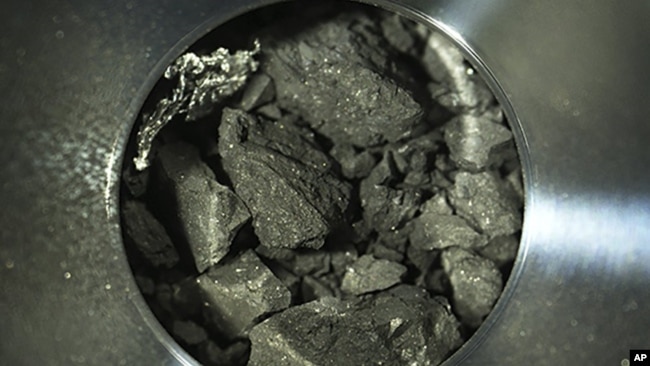はやぶさ2の偉業
私たちにとっては、嬉しい報道です!!!
余り日本の話題が登場することはありませんからねぇ。
とはいえ、はやぶさ2は帰還することなく、また宇宙の旅へ。。。
その任務が完了すると大気圏突入時に燃えて消滅する運命。
涙なくしては、地球を遠ざかるはやぶさを見送ることは出来ませんでした。物体とはいえ、けなげ( ;∀;)
最後にさりげなくアメリカのヌ話題を入れてるところが、やはりVOA.
万感の思いを込め、
さぁ、今日も下記の単語を頭に入れて
bedrock:岩
meteorite:隕石
Let' listen!!!
日本、最新の小惑星サンプルに満足
Japan Pleased with Latest Asteroid Samples
January 02, 2021

宇宙航空研究開発機構(JAXA)から提供された光学顕微鏡写真は、「はやぶさ」2号機が持ち帰ったカプセルのCコンパートメント内に見られる土のサンプルを示しています。(JAXA via AP)
日本の当局者は、宇宙船によって収集され、地球に戻された小惑星の物質の品質に満足していると述べています。
先週、宇宙航空研究開発機構(JAXA)の関係者は、2019年7月に小惑星 竜宮 から採取されたサンプルについて説明しました。竜宮は地球から3億キロ以上離れた場所に鎮座しています。
日本の無軌道探査機 はやぶさ2 は、小惑星に穴を開けて爆破した後、物質を持ち帰りました。
宇宙機関は、2019年7月のミッションは、竜宮の表面下からサンプルを採取することを目的としていると述べていました。2019年2月に行われた以前の作業では、はやぶさ2 は小惑星の別の部分から物質を採取しました。
2回目の収集作業では、1cmほどの大きさのサンプル片が得られたとJAXA関係者は述べています。黒い物質は木炭に似ていて、非常に硬かったとのことです。採取し、別の容器に入れても、バラバラになることはありませんでした。
今月初め、宇宙関係者は、はやぶさ2 が最初のミッションで取り出したサンプルは、より小さくて砂のようなものだったと説明しています。それらは、竜宮の地表から採取されたものでした。
はやぶさ2は2014年12月に打ち上げられ、2018年6月に竜宮の近くに到着しました。日本の宇宙ミッションは、このサンプルを使って、太陽系がどのように形成されたかをより深く知ることを目指しています。
JAXAの臼井智弘氏は宇宙物質科学者です。彼は、7月に2セット目のサンプルを取得するために、はやぶさ2は小惑星の表面の下に爆風を当てるインパクターを使用したと、AP通信に話しています。これは、宇宙放射線やその他の環境条件の影響を受けない物質を採取することを目的としていました。
臼井さんは、この大きさの違いは、小惑星の岩盤の硬さの違いを示唆していると指摘しています。臼井さんは、「2回目の着地場所が硬い岩盤で、より大きな粒子が割れてコンパートメントに入った可能性も考えられます」と話しています。
JAXAでは、来年の本格的な研究に向けて、小惑星サンプルの調査を続けています。日本での調査に続き、サンプルの一部は、米国の宇宙機関であるNASAやその他の国際宇宙機関に提供され、さらなる研究が行われる予定です。
小惑星は太陽を周回しているが、惑星よりもはるかに小さいものです。小惑星は太陽系の中で最も古い天体の一つであり、科学者が地球がどのように発展してきたかを理解するのに役立つかもしれません。小惑星のサンプルは、このような神秘的な岩石を研究する貴重な機会を与えてくれます。
はやぶさ2は、現在、1998KY26と呼ばれる小型の小惑星へのミッションにも取り組んでいます。JAXAは、はやぶさ2がその小惑星に到達するまでに11年かかると予想しています。はやぶさ2の新しいミッションの目的は、大きな隕石が地球に落ちてこないようにする方法を研究することです。
小惑星のサンプル採取に成功しているのは米国だけです。NASAは先月、探査機 Osiris-Rex オシリス・レックスが小惑星Bennuベヌのサンプル採取作業を完了したと発表しました。NASAは、探査機が予想以上に多くのサンプルを採取できたことを喜んでいると述べています。
後記
宇宙関連の報道でいつも思うのですが、各国のスタンスって、結局、道徳に導かれているなって。
表面的な目的ではなく、真の狙いについてです。
隕石衝突を回避する目的のはやぶさとは違い、宇宙へ到達できる能力保有の誇示だったり、誰が月を所有できるか、または通信網を牛耳るための衛星数だったり。
人類共通の有益さを共有しようとする心、それって結局、道徳心。それを養う”教育の力”。
でも、究極の万国共通の”道徳心”って難しいと思っています。
文化的背景、宗教教義、地理的背景が左右するからです。
政治、経済、貧富により世界は真っ二つに引き裂かれそうで、恐怖を感じます。
”地球を救う” ここだけはどうかみんなで共有したいと願います。
Japan Pleased with Latest Asteroid Samples
 This optical microscope photo provided by the Japan Aerospace Exploration Agency (JAXA), shows soil samples seen inside C compartment of the capsule brought back by Hayabusa2. (JAXA via AP)
This optical microscope photo provided by the Japan Aerospace Exploration Agency (JAXA), shows soil samples seen inside C compartment of the capsule brought back by Hayabusa2. (JAXA via AP)
Japanese officials say they are pleased with the quality of asteroid material collected by a spacecraft and returned to Earth.
Last week, officials from the Japan Aerospace Exploration Agency, JAXA, described the samples, which were collected from the Ryugu asteroid in July 2019. Ryugu sits more than 300 million kilometers from Earth.
Japan’s unpiloted Hayabusa2 spacecraft removed the material after blasting a hole into the asteroid.
The space agency said the July 2019 mission aimed to collect samples from below the surface of Ryugu. During an earlier operation in February 2019, Hayabusa2 collected material from a different part of the asteroid.
The second collection effort resulted in sample pieces as big as 1 centimeter, JAXA officials said. The black material looked similar to charcoal and was very hard, they added. It did not break apart when picked up or poured into another container.
Earlier this month, space officials described the samples Hayabusa2 removed on its first mission as smaller, sandy pieces. They were collected from the surface of Ryugu.
Hayabusa2 was launched in December 2014 and arrived near Ryugu in June 2018. The Japanese space mission aims to use the samples to learn more about how our solar system formed.
JAXA’s Tomohiro Usui is a space materials scientist. He told The Associated Press that to get the second set of samples in July, Hayabusa2 used an impactor to blast below the asteroid’s surface. The aim was to collect material unaffected by space radiation or other environmental conditions.
Usui noted that the size differences suggest different hardness of the bedrock of the asteroid. “One possibility is that the place of the second touchdown was a hard bedrock and larger particles broke and entered the compartment,” Usui said.
JAXA is continuing its examinations of the asteroid samples ahead of fuller studies next year. Following studies in Japan, some of the samples will be shared with the U.S. space agency NASA and other international space agencies for additional research.
Asteroids orbit the sun but are much smaller than planets. They are among the oldest objects in the solar system, and may help scientists better understand how Earth developed over time. The asteroid samples can give researchers a rare chance to study these mysterious rocky objects.
Hayabusa2 is now on another mission to a smaller asteroid, called 1998KY26. JAXA expects the aircraft to take 11 years to reach that asteroid. Hayabusa2’s new mission aims to study possible ways to prevent large meteorites from hitting Earth.
The only other nation to successfully collect an asteroid sample is the United States. NASA announced last month that its Osiris-Rex spacecraft had completed the sample operation on the asteroid Bennu. NASA said it was pleased the spacecraft collected more sample material than expected.
________________________________________________
Words in This Story
asteroid – n. any one of thousands of small planets that circle around the sun
mission – n. a flight by an aircraft or spacecraft to perform a specific task
charcoal – n. a hard black material that is made by burning wood with a small amount of air
impactor – n. an object (such as a meteorite) that collides with another body
bedrock – n. the solid rock that lies under the surface of the ground
compartment – n. an enclosed space or area that is usually part of something larger and is often used to hold a specific thing
meteorite – n. a piece of rock or metal that has fallen to the ground from outer space : a meteor that reaches the surface of the Earth without burning up entirely